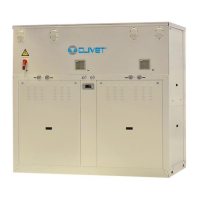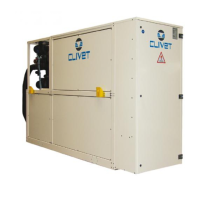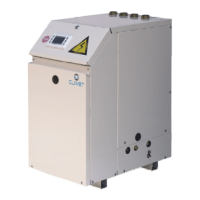Do you have a question about the CLIVET WSH-XEE2 Series and is the answer not in the manual?
Provides correct unit installation, use, and maintenance instructions, with warnings.
States that only qualified personnel can operate the unit as per regulations.
Discusses risks during design, operation, installation, and maintenance.
Specifies the unit's intended use for cooling/heating water or glycol mix.
Covers outdoor installation, positioning, and electrical line compliance.
Recommends periodic inspection and maintenance for cost reduction.
Advises immediate deactivation and contacting service agents for breakdowns.
Outlines installer's responsibility to train users on operation and maintenance.
Advises keeping the manual accessible and noting unit interventions.
Provides step-by-step instructions for safe unit handling and lifting.
Defines functional spaces for unit operation, maintenance, and safety.
Lists criteria for choosing the installation place, ensuring fixed positions and vibration control.
Details required water features and consequences of inadequate quality.
Advises on measures to prevent freezing if temperatures approach 0°C.
Describes how to perform hydraulic connections and union welding.
Details the step-by-step operation sequence for unit start-up.
Describes the energy recovery option for hot water production during cooling.
Explains electrical data found on the serial number label and matriculation plate.
Provides steps for electrical connections, including safety checks and isolation.
Explains how to connect a PC to the unit for configuration and control.
Describes options for remote control setup, including user interface and power supply.
States that start-up must be done by qualified technicians and outlines prerequisite checks.
Lists essential checks before powering up the unit in OFF state.
Details the sequence of operations for starting the unit ON.
Covers checks for the refrigeration circuit, including oil stains and pressure.
Details checks for the water circuit, ensuring it's clean, filled, and pressurized.
Focuses on checks for grounding, conductor tightness, and voltage/phase balance.
Explains how to limit absorbed electric power using an external signal.
Details how to adjust temperature setpoints for cooling and heating.
Provides instructions for identifying, resetting, and managing alarms.
Lists and describes various alarm codes and their meanings.
Recommends inspections every 6 months, depending on usage frequency.
Lists risks associated with incorrect installation, such as leaks and electric shock.
Details risks related to electrical connections, sizing, and earthing.
Describes risks from refrigerant expulsion, leaks, or heating of the circuit.
Provides correct unit installation, use, and maintenance instructions, with warnings.
States that only qualified personnel can operate the unit as per regulations.
Discusses risks during design, operation, installation, and maintenance.
Specifies the unit's intended use for cooling/heating water or glycol mix.
Covers outdoor installation, positioning, and electrical line compliance.
Recommends periodic inspection and maintenance for cost reduction.
Advises immediate deactivation and contacting service agents for breakdowns.
Outlines installer's responsibility to train users on operation and maintenance.
Advises keeping the manual accessible and noting unit interventions.
Provides step-by-step instructions for safe unit handling and lifting.
Defines functional spaces for unit operation, maintenance, and safety.
Lists criteria for choosing the installation place, ensuring fixed positions and vibration control.
Details required water features and consequences of inadequate quality.
Advises on measures to prevent freezing if temperatures approach 0°C.
Describes how to perform hydraulic connections and union welding.
Details the step-by-step operation sequence for unit start-up.
Describes the energy recovery option for hot water production during cooling.
Explains electrical data found on the serial number label and matriculation plate.
Provides steps for electrical connections, including safety checks and isolation.
Explains how to connect a PC to the unit for configuration and control.
Describes options for remote control setup, including user interface and power supply.
States that start-up must be done by qualified technicians and outlines prerequisite checks.
Lists essential checks before powering up the unit in OFF state.
Details the sequence of operations for starting the unit ON.
Covers checks for the refrigeration circuit, including oil stains and pressure.
Details checks for the water circuit, ensuring it's clean, filled, and pressurized.
Focuses on checks for grounding, conductor tightness, and voltage/phase balance.
Explains how to limit absorbed electric power using an external signal.
Details how to adjust temperature setpoints for cooling and heating.
Provides instructions for identifying, resetting, and managing alarms.
Lists and describes various alarm codes and their meanings.
Recommends inspections every 6 months, depending on usage frequency.
Lists risks associated with incorrect installation, such as leaks and electric shock.
Details risks related to electrical connections, sizing, and earthing.
Describes risks from refrigerant expulsion, leaks, or heating of the circuit.
| Series | WSH-XEE2 |
|---|---|
| Category | Chiller |
| Power Supply | 400V/3Ph/50Hz |
| Refrigerant | R134a |
| Sound Pressure Level | 68 - 77 dB(A) (depending on the model) |
| Operating Temperature Range (Cooling) | 15 to 48 °C (ambient) |
| Operating Temperature Range (Heating) | -10 to 35 °C (ambient) |
| IP Rating | IP54 |











